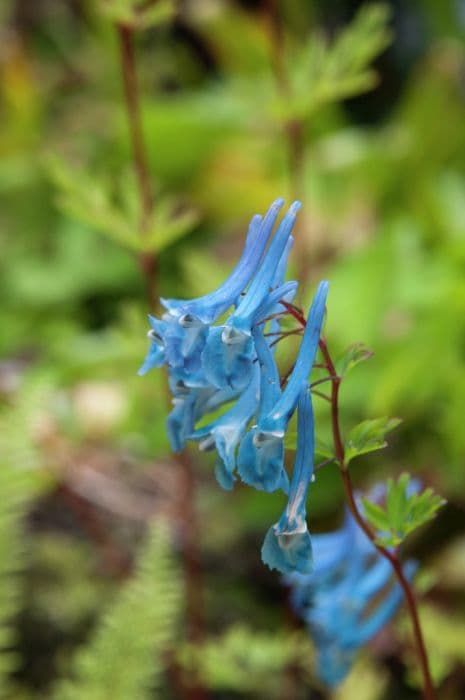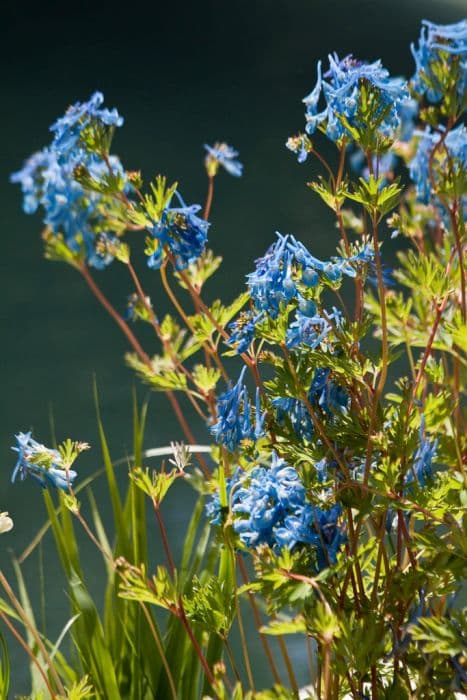Yellow Fumewort Corydalis decipiens misapplied

ABOUT
The plant commonly referred to as Corydalis presents a visually intricate and delicate structure. The foliage is typically a soft green color, producing fern-like leaves that are finely divided, giving a lacy appearance. The arrangement of these leaves is lush, contributing to the plant’s overall feathery texture. On top of these attractive leaves, the plant bears distinctive flowers, which are often tubular and spurred. These blooms come in a variety of colors, including shades of yellow, pink, purple, and blue, each adding a pop of color that contrasts beautifully with the greenery. These flowers are generally clustered along the top of slender, arching stems, enhancing the delicate appearance of the plant. The root system might include bulb-like structures or rhizomes, which allow the plant to spread and sometimes naturalize in an area, creating a soothing blanket or drift of foliage and flowers. Overall, this plant presents a delicate and ornamental character that is highly prized in garden settings for its intricate leaves and charming flowers.
About this plant
 Names
NamesFamily
Papaveraceae
Synonyms
False Fumewort
Common names
Capnoides decipiens, Corydalis bracteata, Corydalis solida.
 Toxicity
ToxicityTo humans
Corydalis, which is misapplied for Corydalis decipiens, is a genus of flowering plants that are known to contain various alkaloids, some of which can be toxic to humans if ingested. The specific toxicity of Corydalis decipiens is not well-documented, but plants in the Corydalis genus can cause symptoms such as gastrointestinal upset, including nausea, vomiting, and diarrhea if ingested in significant quantities. In some cases, the alkaloids may affect the central nervous system leading to fatigue, dizziness, or changes in heart rhythm. It is important to avoid ingesting parts of plants from the Corydalis genus due to the potential consequences of these toxic compounds.
To pets
Corydalis, the common reference for Corydalis decipiens, can be toxic to pets, including dogs and cats, as it contains a variety of alkaloids that may affect them negatively. While specific data on Corydalis decipiens' toxicity to pets is lacking, ingestion of plants from the Corydalis genus by pets can lead to symptoms similar to those observed in humans, such as vomiting, diarrhea, and possibly tremors or seizures in more severe cases due to the effect on the nervous system. If a pet ingests any part of a Corydalis plant, it is crucial to seek veterinary care promptly due to the potential toxic effects.
 Characteristics
CharacteristicsLife cycle
Perennials
Foliage type
Deciduous
Color of leaves
Green
Flower color
Varies
Height
1 foot (0.3 meters)
Spread
1 foot (0.3 meters)
Plant type
Herb
Hardiness zones
5
Native area
Asia
Benefits
 General Benefits
General Benefits- Ornamental Value: Corydalis decipiens, commonly known as Corydalis, adds ornamental appeal to gardens with its delicate foliage and attractive flowers.
- Wildlife Attraction: The plant's flowers can attract pollinators such as bees and butterflies, enhancing biodiversity in the garden.
- Shade Tolerance: Corydalis thrives in shaded areas, making it suitable for planting under trees or in parts of the garden that receive less sunlight.
- Soil Erosion Control: The root system of Corydalis can help stabilize soil and prevent erosion, particularly on slopes or banks.
- Seasonal Interest: With its spring blooms, Corydalis provides seasonal interest and adds a burst of color to the garden after winter.
- Low Maintenance: This plant generally requires minimal care once established, making it a good choice for gardeners seeking low-maintenance landscaping options.
 Medical Properties
Medical Properties- Analgesic: Corydalis species have compounds that can help alleviate pain.
- Sedative: Some Corydalis extracts may produce a calming effect and help with sleep disturbances.
- Antispasmodic: It has been traditionally used to relieve muscle spasms and cramps.
- CNS depressant: Possible effects on the central nervous system, potentially reducing anxiety and stress responses.
 Air-purifying Qualities
Air-purifying QualitiesThis plant is not specifically known for air purifying qualities.
 Other Uses
Other Uses- Corydalis plants are sometimes used in ornamental gardens for their attractive foliage and delicate flowers, adding a splash of color to shady spots.
- The crushed foliage can emit a distinct smell which may deter certain garden pests, providing a natural form of pest control.
- Some people use the seeds of Corydalis plants in sachets as a natural moth repellent to protect clothes and linens.
- In traditional practices, the plant has been used to make dyes or inks due to the presence of alkaloids that can produce color.
- Corydalis is occasionally used in floral arrangements, especially in wildflower bouquets, to give a delicate and feathery texture.
- The plant can be included in a "moon garden," where its light-colored flowers are admired under the moonlight, providing night-time interest.
- Some Corydalis species are used in butterfly gardens as they can attract and support pollinators like bees and butterflies.
- Due to its tendency to spread, Corydalis can be used as a ground cover in areas where other plants struggle to grow.
- Corydalis has been mentioned in literary works and poetry, symbolizing elusive happiness or fleeting beauty.
- The plant's seed pods, which snap open when ripe to disperse seeds, are sometimes used in educational settings to demonstrate mechanical seed dispersal.
Interesting Facts
 Feng Shui
Feng ShuiThe Corydalis is not used in Feng Shui practice.
 Zodiac Sign Compitability
Zodiac Sign CompitabilityThe Corydalis is not used in astrology practice.
 Plant Symbolism
Plant Symbolism- Elusiveness: The Corydalis plant, commonly known as Fumewort, due to its tendency to appear and disappear with the seasons, symbolizes the elusive nature of happiness or love that can suddenly emerge and then fade away.
- Adaptability: As the Fumewort can thrive in varied conditions, it is often seen as a symbol of adaptability and the ability to prosper in diverse environments or situations.
- Resolve: This plant has the determination to push through hard soils and rocks to bloom, representing the idea of overcoming difficulties through perseverance and inner strength.
 Water
WaterThe Pacific bleeding heart should be watered regularly to keep the soil consistently moist but not waterlogged. During the growing season, water the plant thoroughly when the top inch of soil feels dry, approximately once a week, using about half a gallon for a medium-sized plant. During the winter months when the plant is dormant, reduce watering frequency but do not let the soil completely dry out. Avoid overhead watering to minimize leaf wetness and reduce the risk of disease. Ensure that the plant has good drainage to prevent root rot.
 Light
LightPacific bleeding hearts thrive in dappled sunlight or part shade. They should be positioned in a spot that receives morning sunlight and protection from the intense afternoon sun. These plants can also grow well in shady areas where they receive filtered light throughout the day. Avoid placing them in full sun, which can scorch their delicate foliage.
 Temperature
TemperaturePacific bleeding hearts prefer cool to moderate temperature conditions, ideally between 60-75°F. They can tolerate minimum temperatures down to about 20°F but should be protected from harsh frosts. Maximum temperature tolerance is around 80°F; beyond this, the plant may go dormant to escape the heat. Placing them in a location where they can enjoy cooler nights and morning sun can help them thrive.
 Pruning
PruningPruning Pacific bleeding hearts is primarily for removing spent flower stems to encourage further blooming and for aesthetic purposes. Prune them after flowering by cutting back the flower stems to the base of the plant. This task is generally needed once a year, typically in late spring or early summer. Pruning also helps to maintain a compact and healthy growth habit.
 Cleaning
CleaningAs needed
 Soil
SoilFor Corydalis (misapplied as Corydalis decipiens), a well-draining soil mix is ideal, consisting of organic matter such as leaf mold or compost, mixed with grit or perlite to promote drainage. The pH should ideally be slightly acidic to neutral, ranging from 6.0 to 7.0.
 Repotting
RepottingCorydalis (misapplied as Corydalis decipiens) generally doesn't require frequent repotting. Repot this plant every 2 to 3 years or when you notice the roots have filled the pot in order to maintain healthy growth.
 Humidity & Misting
Humidity & MistingCorydalis (misapplied as Corydalis decipiens) thrives in moderate humidity levels, ideally between 40% to 60%. Avoid placing this plant in overly dry environments which can stress the plant.
 Suitable locations
Suitable locationsIndoor
Keep Corydalis in bright, indirect light indoors and moist soil.
Outdoor
Plant Corydalis in dappled shade, moist soil, and shelter from wind.
Hardiness zone
5-7 USDA
 Life cycle
Life cycleCorydalis decipiens, commonly known as Larkspur or False Fumewort, begins its life cycle as a seed, which after a period of dormancy, germinates in moist, cool conditions, typically in the spring. The seedling emerges, developing a rosette of leaves at the soil surface. As the plant grows, it develops a stem and foliage, entering the vegetative stage, during which it matures and the root system expands. Once matured, it produces flowers, which are typically purple or bluish, attracting pollinators for sexual reproduction. Following pollination, seeds form inside the capsules, which, when mature, disperse into the surrounding environment. The plant then enters senescence and dies, completing its life cycle, while the seeds lay dormant until conditions are favorable for the next generation to begin the cycle anew.
 Propogation
PropogationPropogation time
Spring to early summer
Propogation: Corydalis decipiens, commonly known as False Fumewort, is most commonly propagated through seed. The best time to sow seeds is in autumn, directly after they are ripe, to allow a period of natural cold stratification which helps break seed dormancy. Fresh seeds are sown onto the surface of a moist, well-drained seed starting mix. The container should then be placed in a cold frame or a similarly protected outdoor environment during the winter. Seeds typically germinate with the onset of spring as temperatures begin to rise. Thin seedlings to prevent overcrowding and transplant them to their final growing positions when they are large enough to handle and the risk of frost has passed.









